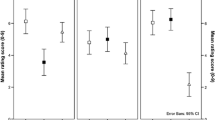Abstract
The present study investigated how valence, arousal, and subjective liking of music affect visually induced motion sickness (VIMS). VIMS is a common side effect when interacting with virtual environments, resulting in discomfort, dizziness, and/or nausea. Music has previously been shown to reduce VIMS, but the precise nature of this effect remains unknown. Eighty participants watched a video of a bicycle ride filmed from a first-person perspective. First, participants (n = 40) were randomly assigned to one of four groups that listened to pre-selected, classical music excerpts varying in valence and arousal (happy, peaceful, agitated, sad) while watching the video. Second, the level of subjective liking of music was maximized by asking participants to select their favourite music (n = 20), which was then played during the video. A control group (n = 20) watched the video without music. VIMS was measured using the Fast Motion Sickness Scale (FMS) and the Simulator Sickness Questionnaire (SSQ). No effects of valence or arousal on VIMS symptoms were found. Instead, we found that VIMS was significantly reduced when music liking was maximized: Participants who listened to their favourite music reported less VIMS compared to those who did not listen to music at all or to pre-selected music that they liked less. Music that is highly liked can, under certain circumstances, successfully reduce VIMS. These effects appear to be independent of the valence and arousal characteristics of the music.





Similar content being viewed by others
Notes
We do acknowledge that felt emotion can be dissociated from perceived emotion such that a participant may, for example, feel “happy” when listening to music that is perceived as “sad”.
References
Bles W, Bos JE, Kruit H (2000) Motion sickness. Curr Opin Neurol 13(1):19–25
Bos JE, Bles W, Groen EL (2008) A theory on visually induced motion sickness. Displays 29:47–57. https://doi.org/10.1016/j.displa.2007.09.002
Bradley MM, Lang PJ (1994) Measuring emotion: the self-assessment manikin and the semantic differential. J Behav Ther Exp Psychiatry 25(1):49–59
Bremmer F, Lappe M (1999) The use of optical velocities for distance discrimination and reproduction during visually simulated self motion. Exp Brain Res 127:33–42. https://doi.org/10.1007/s002210050771
Chang C-H, Pan W-W, Chen F-C, Stoffregen TA (2013) Console video games, postural activity, and motion sickness during passive restraint. Exp Brain Res 229:235–242. https://doi.org/10.1007/s00221-013-3609-y
Choukèr A, Kaufmann I, Kreth S, Hauer D, Feuerecker M, D. et al (2010) Motion sickness, stress and the endocannabinoid system. PLoS ONE. https://doi.org/10.1371/journal.pone.0010752
Dalton BH, Behm DG (2007) Effects of noise and music on human and task performance: a systematic review. Occup Ergon 7:143–152
Davis WB, Thaut MH (1989) The influence of preferred relaxing music on measures of state anxiety, relaxation, and physiological responses. J Music Therapy 26:168–187. https://doi.org/10.1093/jmt/26.4.168
de la Torre-Luque A, Diaz-Piedra C, Buela-Casal G (2017) Effects of preferred relaxing music after acute stress exposure: a randomized controlled trial. Psychol Music 45:795–813. https://doi.org/10.1177/03005735617689953
Ebenholtz SM (1992) Motion sickness and oculomotor systems in virtual environments. Presence Teleoper Virtual Environ 1:302–305. https://doi.org/10.1162/pres.1992.1.3.302
Ellis RJ, Thayer JF (2010) Music and autonomic nervous system (dys)function. Music Percept 27:317–326. https://doi.org/10.1525/mp.2010.27.4.317
Ezzone S, Baker C, Rosselet R, Terepka E (1998) Music as an adjunct to antiemetic therapy. Oncol Nurs Forum 25(9):1551–1556
Farmer AD, Al Omran Y, Aziz Q, Andrews PL (2014) The role of the parasympathetic nervous system in visually induced motion sickness: systematic review and meta-analysis. Exp Brain Res 232:2665–2673. https://doi.org/10.1007/s00221-014-3964-3
Gimeno MM (2010) The effect of music and imagery to induce relaxation and reduce nausea and emesis in patients with cancer undergoing chemotherapy treatment. Music Med 2:174–181. https://doi.org/10.1177/1943862110374622
Golding JF (2006a) Motion sickness susceptibility. Auton Neurosci 129:67–76. https://doi.org/10.1016/j.autneu.2006.07.019
Golding JF (2006b) Predicting individual differences in motion sickness susceptibility by questionnaire. Pers Indiv Differ 41:237–248. https://doi.org/10.1016/j.paid.2006.01.012
Golding JF, Gresty MA (2015) Pathophysiology and treatment of motion sickness. Curr Opin Neurol 28:83–88. https://doi.org/10.1097/WCO.0000000000000163
Heeter C (1992) Being there: the subjective experience of presence. Presence Teleoper Virtual Environ 1:262–271. https://doi.org/10.1162/pres.1992.1.2.262
Janata P, Tomic ST, Rakowski SK (2007) Characterisation of music-evoked autobiographical memories. Memory 15:845–860. https://doi.org/10.1080/09658210701734593
Karagozoglu S, Tekyasar F, Yilmaz FA (2013) Effects of music therapy and guided visual imagery on chemotherapy-induced anxiety and nausea-vomiting. J Clin Nurs 22:39–50. https://doi.org/10.1111/jocn.12030
Kennedy RS, Lane NE, Berbaum KS, Lilienthal MG (1993) Simulator sickness questionnaire: an enhanced method for quantifying simulator sickness. Int J Aviat Psychol 3:203–220. https://doi.org/10.1207/s15327108ijap0303_3
Kennedy RS, Stanney KM, Dunlap WP (2000) Duration and exposure to virtual environments: sickness curves during and across sessions. Presence Teleoper Virtual 9:463–472. https://doi.org/10.1162/105474600566952
Kennedy RS, Drexler J, Kennedy RC (2010) Research in visually induced motion sickness. Appl Ergon 41:494–503. https://doi.org/10.1016/j.apergo.2009.11.006
Keshavarz B (2016) Exploring behavioral methods to reduce visually induced motion sickness in virtual environments. In: Lackey S, Shumaker R (eds) Virtual, augmented and mixed reality. Springer International Publishing, Berlin, pp 147–155. https://link.springer.com/10.1007/978-3-319-39907-2_14. Accessed 22 Aug 2016
Keshavarz B, Hecht H (2011) Validating an efficient method to quantify motion sickness. Hum Fact J Hum Fac Ergon Soc 53:415–426. https://doi.org/10.1177/0018720811403736
Keshavarz B, Hecht H (2014) Pleasant music as a countermeasure against visually induced motion sickness. Appl Ergon 45:521–527. https://doi.org/10.1016/j.apergo.2013.07.009
Keshavarz B, Hecht H, Lawson BD (2014) Visually induced motion sickness: characteristics, causes, and countermeasures. In: Hale KS, Stanney KM (eds) Handbook of virtual environments: design, implementation, and applications, 2nd edn. CRC Press, Boca Raton, pp 648–697
Keshavarz B, Stelzmann D, Paillard A, Hecht H (2015) Visually induced motion sickness can be alleviated by pleasant odors. Exp Brain Res 233:1353–1364. https://doi.org/10.1007/s00221-015-4209-9
Keshavarz B, Novak AC, Hettinger LJ, Stoffregen TA, Campos JL (2017) Passive restraint reduces visually induced motion sickness in older adults. J Exp Psychol Appl. https://dx.doi.org.myaccess.library.utoronto.ca/10.1037/xap0000107
Labbé E, Schmidt N, Babin J, Pharr M (2007) Coping with stress: the effectiveness of different types of music. Appl Psychophysiol Biofeedback 32:163–168. https://doi.org/10.1007/s10484-007-9043-9
Mack GA, Skillings JH (1980) A Friedman-type rank test for main effects in a two-factor ANOVA. J Am Stat Assoc 75:947–951. https://doi.org/10.1080/01621459.1980.10477577
Miller KE, Muth ER (2004) Efficacy of acupressure and acustimulation bands for the prevention of motion sickness. Aviat Space Environ Med 75(8):227–234
Mitchell LA, MacDonald RAR (2006) An experimental investigation of the effects of preferred and relaxing music listening on pain perception. J Music Ther 43:295–316. https://doi.org/10.1093/jmt/43.4.295
Mitchell LA, MacDonald RAR, Brodie EE (2006) A comparison of the effects of preferred music, arithmetic and humour on cold pressor pain. Eur J Pain 10:343–351. https://doi.org/10.1016/j.ejpain.2005.03.005
Muth ER (2006) Motion and space sickness: intestinal and autonomic correlates. Auton Neurosci 129:58–66. https://doi.org/10.1016/j.autneu.2006.07.020
Oman CM (1990) Motion sickness: a synthesis and evaluation of the sensory conflict theory. Can J Physiol Pharmacol 68:294–303. https://doi.org/10.1139/y90-044
Orini M, Bailón R, Enk R, Koelsch S, Mainardi L, Laguna P (2010) A method for continuously assessing the autonomic response to music-induced emotions through HRV analysis. Med Biol Eng Comput 48:423–433. https://doi.org/10.1007/s11517-010-0592-3
Otto B, Riepl RL, Klosterhalfen S, Enck P (2006) Endocrine correlates of acute nausea and vomiting. Auton Neurosci 129:17–21. https://doi.org/10.1016/j.autneu.2006.07.010
Pereira CS, Teixeira J, Figueiredo P, Xavier J, Castro SL, Brattico E (2011) Music and emotions in the brain: familiarity matters. PLoS ONE 6:e27241. https://doi.org/10.1371/journal.pone.0027241
Reason JT (1978) Motion sickness adaptation: a neural mismatch model. J R Soc Med 71:819–829
Reason JT, Brand JJ (1975) Motion sickness. Academic Press, London
Riccio GE, Stoffregen TA (1991) An ecological theory of motion sickness and postural instability. Ecol Psychol 3:195–240. https://doi.org/10.1207/s15326969eco0303_2
Russell JA (1980) A circumplex model of affect. J Pers Soc Psychol 39:1161–1178. https://doi.org/10.1037/h0077714
Russo FA, Vempala NN, Sandstrom GM (2013) Predicting musically induced emotions from physiological inputs: linear and neural network models. Front Psychol. https://doi.org/10.3389/fpsyg.2013.00468
Sandstorm GA, Russo FA (2010) Music hath charms: the effects of valence and arousal on recovery following an acute stressor. Music Med 2:137–143. https://doi.org/10.1177/1943862110371486
Schellenberg EG, Peretz I, Vieillard S (2008) Liking for happy- and sad-sounding music: effects of exposure. Cognit Emot 22:218–237. https://doi.org/10.1080/02699930701350753
Shupak A, Gordon CR (2006) Motion sickness: advances in pathogenesis, prediction, prevention, and treatment. Aviat Space Environ Med 77(12):1213–1223
Standley JM (1992) Clinical applications of music and chemotherapy: the effects on nausea and emesis. Music Therapy Perspect 10:27–35. https://doi.org/10.1093/mtp/10.1.27
Stanney K, Salvendy G, Deisinger J, DiZio P, Ellis S et al (1998) Aftereffects and sense of presence in virtual environments: formulation of a research and development agenda. Int J Hum Comput Interact 10:135–187. https://doi.org/10.1207/s15327590ijhc1002_3
Tomczak M, Tomczak E (2014) The need to report effect size estimates revisited. An overview of some recommended measures of effect size. TSS 1(21):19–25
Uchino M, Ishii K, Kuwahara M, Ebukuro S, Tsubone H (2001) Role of autonomic nervous system for development and suppression of motion sickness in Suncus murinus. Auton Neurosci 94:46–51. https://doi.org/10.1016/S1566-0702(01)00344-7
Vuoskoski JK, Eerola T (2012) Can sad music really make you sad? Indirect measures of affective states induced by music and autobiographical memories. Psychol Aesthet Creat Arts 6:204–213. https://doi.org/10.1037/a0026937
Witvliet CV, Vrana SR (1998) Play it again Sam: repeated exposure to emotionally evocative music polarises liking and smiling responses, and influences other affective reports, facial EMG, and heart rate. Cognit Emot 21:3–25. https://doi.org/10.1080/026999306010000672
Wobbrock JO, Findlater L, Gergle D, Higgins JJ (2011) The aligned rank transform for nonparametric factorial analyses using only ANOVA procedures. In: Proceedings of the 2011 annual conference on human factors in computing systems-CHI’11, ACM Press, Vancouver, BC, Canada, p 143. https://doi.org/10.1145/1978942.1978963
Yen Pik Sang FD, Golding JF, Gresty MA (2003) Suppression of sickness by controlled breathing during mildly nauseogenic motion. Aviat Space Environ Med 74(9):998–1002
Young LR, Sienko KH, Lyne LE, Hecht H, Natapoff A (2003) Adaptation of the vestibulo-ocular reflex, subjective tilt, and motion sickness to head movements during short-radius centrifugation. J Vestib Res 13(2–3):65–77
Funding
This research received no specific grant from any funding agency in the public, commercial, or non-for-profit sectors.
Author information
Authors and Affiliations
Corresponding author
Ethics declarations
Conflict of interest
The authors declare that they have no conflict of interest.
Additional information
Communicated by Francesca Frassinetti.
Publisher's Note
Springer Nature remains neutral with regard to jurisdictional claims in published maps and institutional affiliations.
Electronic supplementary material
Below is the link to the electronic supplementary material.
Rights and permissions
About this article
Cite this article
Peck, K., Russo, F., Campos, J.L. et al. Examining potential effects of arousal, valence, and likability of music on visually induced motion sickness. Exp Brain Res 238, 2347–2358 (2020). https://doi.org/10.1007/s00221-020-05871-2
Received:
Accepted:
Published:
Issue Date:
DOI: https://doi.org/10.1007/s00221-020-05871-2




